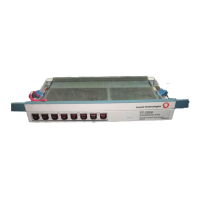Maintenance Description
Issue 8.0 July 2002
9-57
Dual Ring Interworking Protection 9
In Release 4.1 and later releases, the FT-2000 OC-48 Add/Drop-Ring Terminal
supports dual ring interworking (DRI) protection switching. DRI protection
switching protects a circuit with a termination in one ring and the other termination
in another ring when an interconnecting node fails. DRI protection switching takes
place in response to an automatically detected incoming SONET EC-1 or DS3
loss-of-signal (LOS) condition or external commands from a local/remote CIT or
operations system. In Release 5 and later releases, DRI protection switching also
takes place in response to an automatically detected unprotected
OC-3/IS-3/OC-12 LOS or loss-of-frame (LOF) condition. Additionally, a path AIS
(AIS-P) triggers a DRI switch. Refer to the FAULT-Switch-Path-STS3 input in
Volume I, Section 11, "Craft Interface Terminal Usage."
NOTE:
With Release 7.1.0 and later software, a path AIS (AIS-P) triggers a DRI
switch. Furthermore, Release 7.1.0 and later releases provide revertive DRI
and thus do automatically switch back to the service fiber.
Table 9-8 shows the standard protection switching priorities in descending order
of priority used by the FT-2000 OC-48 Add/Drop-Rings Terminal.
For Release 7.0 and earlier releases, DRI protection switching is unidirectional
and manually revertive. Unidirectional refers to when protection switching is
performed in one direction only
. For a given 1-way circuit, DRI protection
switching is only performed in the add direction. When a fault clears, traffic
switches from the primary to secondary node. When the fault clears, traffic does
not
automatically switch back (revert) to the primary node. Therefore, if the
secondary node fails, traffic will not automatically switch back (revert) to the
primary node. A reset
must
be performed using the FAULT-SWITCH-PATH-STS3
or FAULT-SWITCH-PATH-STS1 input to clear an active manual or automatic DRI
switch.
Table 9-8. Dual Ring Interworking Protection Switching Priorities
Switch Priority (Descending Order) Source of Request
Reset* CIT/OS
DS3/EC1 loss of signal (LOS)† Automatic
Unprotected OC-3/OC-12 LOS or loss of frame
(LOF)†
Automatic
Manual switch CIT/OS
* Reset performed using the FAULT-Switch-Path-STS3 or the
FAULT-Switch-Path-STS1 input.
† A DS3/EC1 LOS and an unprotected OC-3/OC-12 LOS or LOF are the same
priority.

